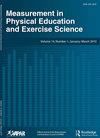Estimation of Lower Body Muscle Power from Vertical Jump in Youth
IF 1.9
4区 教育学
Q2 EDUCATION & EDUCATIONAL RESEARCH
Measurement in Physical Education and Exercise Science
Pub Date : 2022-02-20
DOI:10.1080/1091367X.2022.2041420
引用次数: 5
Abstract
ABSTRACT Incorporation of the vertical jump (VJ) test in health-related fitness batteries is predicated on the availability of prediction equations to accurately estimate VJ power. The purpose was to develop and validate a generalizable equation to estimate VJ power from VJ height, body mass, age, and sex in 10- to 18-year-olds. The sample (N = 529) performed a VJ test and had VJ power assessed via mechanography. Validation and cross-validation groups were randomly formed to assess accuracy. Results indicated that estimates of VJ power from VJ height and body mass were accurate (R = .93, SEE = 275 Watts). Age and sex did not add substantially to the model. Upon cross-validation, accuracy was maintained. The newly developed model was more accurate than previously published equations. The following equation provides accurate and feasible estimates of VJ power (Watts) = −1354.820 + (35.455*VJ[cm]) + (43.942*body mass[kg]). This equation provides a feasible way to estimate power in field-based settings.青少年垂直起跳下半身肌肉力量的估计
在健康健身电池中引入垂直跳跃(VJ)测试是基于预测方程的可用性来准确估计VJ功率。目的是开发和验证一个可推广的方程,以估计VJ的高度,体重,年龄和性别在10至18岁的VJ功率。样本(N = 529)进行了VJ测试,并通过力学方法评估了VJ功率。随机组成验证组和交叉验证组以评估准确性。结果表明,由VJ身高和体重估算的VJ功率是准确的(R = 0.93, SEE = 275 Watts)。年龄和性别对模型没有实质性的影响。通过交叉验证,保持了准确性。新开发的模型比以前发表的方程更精确。下面的公式提供了准确可行的VJ功率(瓦)估计=−1354.820 + (35.455*VJ[cm]) +(43.942*体重[kg])。该方程提供了一种可行的方法来估计基于现场设置的功率。
本文章由计算机程序翻译,如有差异,请以英文原文为准。
求助全文
约1分钟内获得全文
求助全文
来源期刊

Measurement in Physical Education and Exercise Science
Medicine-Orthopedics and Sports Medicine
CiteScore
4.20
自引率
33.30%
发文量
24
期刊介绍:
The scope of Measurement in Physical Education and Exercise Science (MPEES) covers original measurement research, special issues, and tutorials within six substantive disciplines of physical education and exercise science. Six of the seven sections of MPEES define the substantive disciplines within the purview of the original research to be published in the journal: Exercise Science, Physical Activity, Physical Education Pedagogy, Psychology, Research Methodology and Statistics, and Sport Management and Administration. The seventh section of MPEES, Tutorial and Teacher’s Toolbox, serves to provide an outlet for review and/or didactic manuscripts to be published in the journal. Special issues provide an avenue for a coherent set of manuscripts (e.g., four to five) to collectively focus in-depth on an important and timely measurement-related issue within the scope of MPEES. The primary aim of MPEES is to publish high-impact manuscripts, most of which will focus on original research, that fit within the scope of the journal.
 求助内容:
求助内容: 应助结果提醒方式:
应助结果提醒方式:


